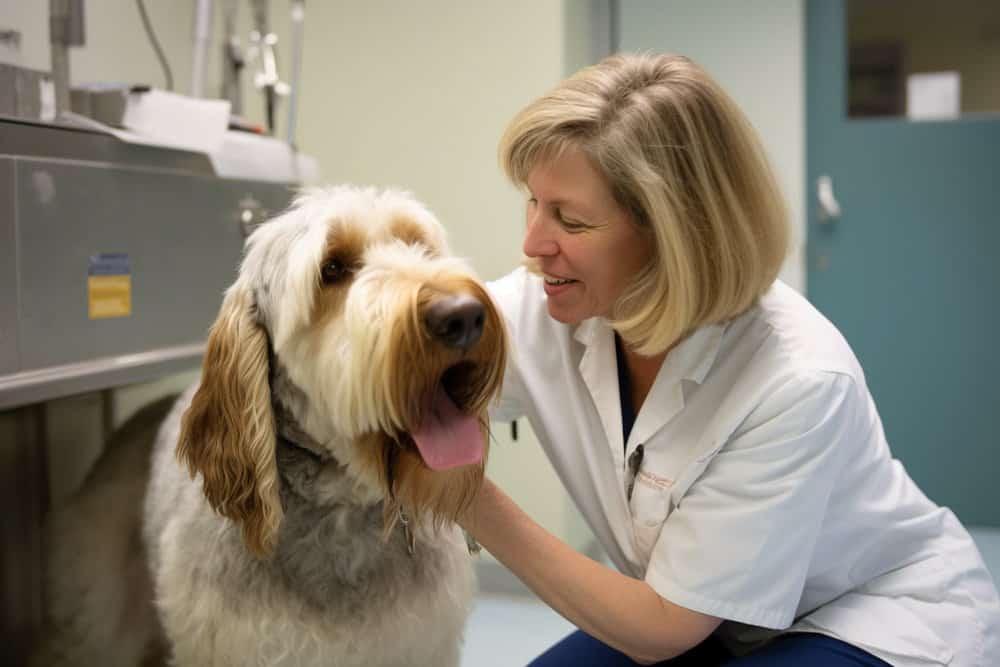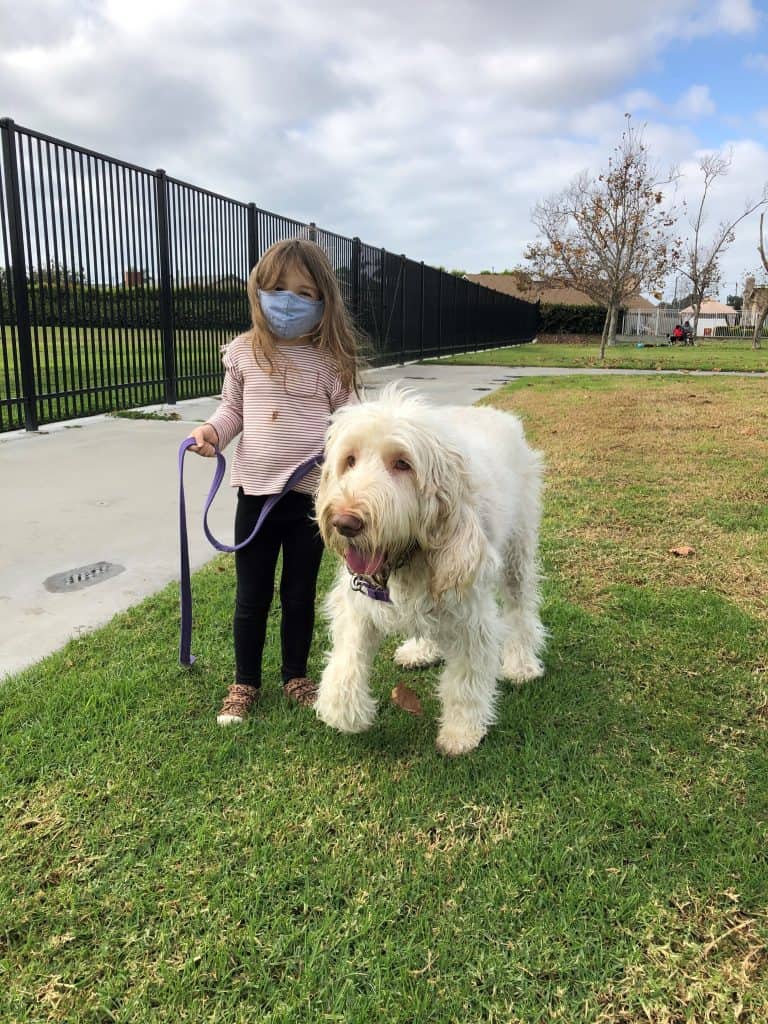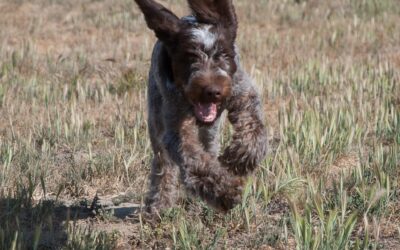As a dog lover and owner of a Spinone with epilepsy, I understand the emotional toll that comes with having a furry friend diagnosed with epilepsy. It can be frustrating and overwhelming to navigate through the complexities of the condition, particularly when it comes to breeds like Spinone Italiano that are predisposed to developing epilepsy and idiopathic epilepsy specifically.
That’s why I have created this comprehensive guide to Italian Spinone and epilepsy, which aims to equip dog owners with valuable information on how best to care for epileptic dogs.
In this guide, you’ll find everything you need to know about Spinone Italiano and epilepsy, from diagnosis and treatment options to living with an epileptic dog. You’ll also discover ways on how you can lessen the effects of epilepsy on your Spinone Italiano as well as learn about current research on the subject.
Additionally, I will share insights into the cost of epilepsy treatment for these dogs and provide a personal story of caring for an epileptic Spinone Italiano.
My hope is that this guide will serve as a helpful resource for anyone dealing with canine epilepsy so that they can give their furry friends the best possible care.
Table of Contents
Understanding Canine Epilepsy
If you want to understand what’s happening in your Spinone Italiano’s brain when they have a seizure, this section breaks down the basic principles of canine epilepsy.
Canine Epilepsy is the most common neurological disorder in dogs and affects dogs of all breeds and ages. It can cause seizures, which can range from mild twitching to more serious episodes with convulsions and loss of consciousness. Epilepsy is not curable, but it can be managed. It is important for pet owners to understand the condition and take steps to ensure the best quality of life for their pets.
The causes of Canine Epilepsy are not fully understood, but it is believed to be due to a combination of genetic and environmental factors. There may also be an underlying problem with the brain or nervous system that is causing the seizures.
Dogs are considered epileptic if they have two or more seizures. Epilepsy is usually divided into two main types:
- Idiopathic, or primary, epilepsy is likely caused by genetics and has no identifiable cause.
- Symptomatic epilepsy, however, stems from an underlying brain lesion (hydrocephalus, tumor, stroke, meningitis etc.) or metabolic cause (liver or kidney disorder, intoxications etc.).
It is important to accurately diagnose which type of epilepsy your dog has. Diagnosis of canine epilepsy involves a complete physical exam, blood work, and sometimes an MRI or CT scan. Treatment is usually with anticonvulsant medications, which can help reduce the frequency and severity of seizures.
Pet owners need to be aware of the signs of canine epilepsy, which can include any of the following:
- Seizures: These can be generalized or partial seizures, and can last from a few seconds to several minutes. During a seizure, the dog may fall to the ground, paddle its legs, lose consciousness, drool, and sometimes urinate or defecate.
- Confusion and disorientation: After a seizure, the dog may seem confused, disoriented, or dazed.
- Unusual behavior: Dogs with epilepsy may exhibit unusual behavior before, during, or after a seizure, such as biting at their own skin, pacing, or appearing restless.
- Loss of balance: During a seizure, the dog may lose its balance and fall over.
- Changes in mood or personality: Some dogs with epilepsy may experience changes in their mood or personality, such as increased aggression or anxiety.
If your pet is showing any of these signs, it is important to seek veterinary care immediately. Regular check-ups and monitoring can help ensure the best possible outcome for your pet. With proper care and monitoring, many dogs with Canine Epilepsy can still lead happy and healthy lives.
In the next section, we’ll dive deeper into how epilepsy specifically affects this breed and what unique considerations owners should keep in mind when caring for their epileptic Spinone Italiano.
Italian Spinone and Epilepsy
Owners of Spinone Italiano dogs may be interested to know that the breed has a higher prevalence of a severe form of epilepsy compared to the general UK dog population, according to a study conducted in 2015 at the Animal Health Trust and supported by the Italian Spinone Club of Great Britain.
It was found that 5.3% of registered Spinoni in the UK had idiopathic epilepsy, which tends to have low remission rates and requires aggressive treatment for cluster seizures. Although antiepileptic medication can help manage seizures, it often causes adverse effects such as excessive hunger, weight gain, and drowsiness.
This news may come as a concern for Spinone Italiano owners who want their beloved pets to live long and healthy lives with good quality. Caring for a dog with epilepsy can be emotionally and physically taxing, especially when dealing with uncontrollable seizures or adverse effects from medication. However, there are ways to improve the quality of life for epileptic dogs and their carers such as early diagnosis, effective treatment plans tailored to individual dogs’ needs, regular vet check-ups, and blood tests to monitor drug levels and liver function.
It is important for Spinone Italiano owners to be aware of the breed’s predisposition to idiopathic epilepsy so they can take preventive measures or seek medical attention when necessary.
Diagnosing epilepsy in dogs involves ruling out other possible causes of seizures such as brain tumors or infections through neurological exams, blood workups, MRI scans, or spinal taps.
In the next section, we will discuss steps that veterinarians take in diagnosing this condition in Spinoni so you can better understand what your furry friend might go through during testing procedures.
Diagnosis of Epilepsy in Spinone Italiano
Diagnosing epilepsy in Spinone Italiano can be a complex process involving a range of tests and examinations to rule out other potential causes of seizures. According to the International Veterinary Epilepsy Task Force’s proposed classification scheme, seizures are primarily classified according to where they begin in the brain. Therefore, diagnosing idiopathic epilepsy in Spinone Italiano requires ruling out structural brain disease as well as metabolic or toxic causes of seizures.

To diagnose epilepsy in Spinone Italiano, veterinarians may recommend several diagnostic tests such as magnetic resonance imaging (MRI) and cerebrospinal fluid (CSF) analysis. These tests help identify any underlying structural abnormalities that may be causing seizures. Additionally, bloodwork is often performed to check for any metabolic imbalances or toxin exposure that could potentially cause seizure activity. Finally, an electroencephalogram (EEG) can confirm the presence of abnormal electrical activity within the brain, which is characteristic of epilepsy.
Here is a list of the tests/procedures your veterinarian may suggest to help them form a diagnosis.
| Test | Purpose | Notes |
| Physical Exam | To check for any abnormalities in your dog’s body and neurological function. | A thorough physical exam is necessary to rule out any underlying medical issues that could be causing seizures. |
| Blood Tests | To check for any underlying health conditions or abnormalities that could be causing seizures. | Blood tests can help identify any metabolic, infectious, or toxic causes of seizures. |
| Urine Analysis | To check for any signs of urinary tract infection or other underlying issues. | Urine analysis can help identify any metabolic or infectious causes of seizures. |
| Electroencephalogram (EEG) | To record the electrical activity in your dog’s brain and diagnose epilepsy. | An EEG can help diagnose epilepsy and determine the type of seizures your dog is experiencing. |
| Magnetic Resonance Imaging (MRI) or Computed Tomography (CT) Scan | To identify structural abnormalities or changes in the brain that could be causing seizures. | MRI or CT scans can help identify any structural or metabolic abnormalities in the brain that could be causing seizures. |
| Spinal Tap | To check for any infections or inflammation in the central nervous system. | A spinal tap may be necessary in some cases to rule out infectious or inflammatory causes of seizures. |
| Video Monitoring | To observe your dog during a seizure and help identify the type of seizure and any triggers. | Video monitoring can help identify the type of seizure your dog is experiencing, which can inform treatment decisions. |
A comprehensive approach to diagnosis ensures that a Spinone Italiano with epilepsy receives appropriate treatment and care tailored to their individual needs. The prevalence of idiopathic epilepsy in this breed is higher than in many other breeds, making it crucial for owners and veterinarians alike to understand how best to manage this condition moving forward into treatment options for epilepsy in Spinone Italiano.
Treatment Options for Epilepsy in Spinone Italiano
Let’s explore the available treatment options for managing seizures in Spinone Italiano with epilepsy. Treatment of idiopathic epilepsy in dogs is primarily focused on reducing seizure frequency and severity, improving quality of life, and minimizing adverse effects associated with antiepileptic medication (AEM).
The choice of AEM depends on several factors including the dog’s age, breed, weight, medical history, and treatment response. Phenobarbital is one of the most commonly used AEMs in Spinone Italiano with epilepsy due to its effectiveness and low cost. However, it can cause liver toxicity and other side effects such as sedation and increased appetite.
Potassium bromide is another AEM that may be used alone or in combination with phenobarbital. It has a lower risk of liver toxicity but can cause vomiting and ataxia.
Veterinarians are increasingly turning to second-generation AEMs like levetiracetam and zonisamide due to their safety and effectiveness in treating various seizure conditions. These drugs have become more popular in the medical field in recent years, as they provide a reliable and safe way to manage seizures in pets. Their efficacy and safety profile make them the preferred drugs for veterinary medicine.
It is important to note that not all epilepsies respond well to drug therapy, so careful monitoring of treatment response is necessary. Additionally, regular bloodwork should be performed to monitor liver function when using certain medications like phenobarbital or potassium bromide.
Living with a Spinone Italiano with Epilepsy
Living with a beloved furry family member who has epilepsy is challenging, but there are ways to manage and support your Spinone Italiano through their seizures.
First and foremost, it’s important to work closely with your veterinarian to develop a treatment plan that works best for your dog’s specific needs. This may include medications, dietary changes, and regular check-ups to monitor the effectiveness of the treatment.
In addition to medical management, there are practical steps you can take at home to help manage your Spinone Italiano’s epilepsy. You should keep a record of seizure activity, including frequency and duration, as well as any triggers that may have preceded the seizure. This information can help you identify patterns and adjust the treatment plan accordingly.
| Date | Time Of Day | Duration | Behaviors Observed During Seizure | Medications Given (if any) | Additional Notes |
| 05/08/2023 | 8:15 AM | 2 minutes | Paddling of legs, drooling | N/A | Dog seemed disoriented for a few minutes after seizure |
| 05/09/2023 | 2:30 PM | 1 minute | Stiffening of legs, whining | Diazepam | Dog appeared to recover quickly |
| 05/12/2023 | 6:45 PM | 3 minutes | Loss of consciousness, shaking | Phenobarbital | Dog was lethargic for several hours after seizure |
In this table, you would record the date and time of day that the seizure occurred, how long it lasted, and any specific behaviors you observed during the seizure. If you gave your dog any medication during or after the seizure, you would note that as well. Finally, you could add any additional notes or observations that might be relevant, such as how your dog acted after the seizure. By keeping track of this information in a table, you can start to look for patterns and potentially identify triggers or other factors that may be contributing to your dog’s seizures.
You may also consider creating a safe space for your dog during seizures, such as a designated area with padded flooring and minimal furniture or obstacles. Living with a Spinone Italiano with epilepsy requires patience and understanding, but it is possible to maintain a good quality of life for both you and your furry companion. With proper medical management and practical strategies in place, you can provide the support that your dog needs while still enjoying all the joys that come with having them in your life.
As we continue our discussion on managing epilepsy in Spinone Italiano dogs, let’s now turn our attention toward the long-term outlook for these furry companions. While idiopathic epilepsy cannot be cured outright, it’s possible to manage the condition effectively over time through medication adjustments and consistent monitoring by veterinary professionals.
In the next section, we’ll explore some of the factors that can impact the prognosis for dogs living with epilepsy long-term.
Long-Term Outlook for Spinone Italiano with Epilepsy
Living with a Spinone Italiano with epilepsy can be challenging, but it’s important to understand the long-term outlook for your furry companion.
According to the Animal Health Trust study mentioned earlier, this breed has a higher prevalence of epilepsy than the general dog population in the UK. However, there are predictors for survival and seizure remission that can improve your dog’s quality of life.
The study found that antiepileptic medication initiation after the second seizure and aggressive treatment of cluster seizures can improve survival time in dogs with idiopathic epilepsy.
It also revealed that females have longer survival than males, neutered dogs survive longer than intact ones, and those who experience cluster seizures anytime in life are at higher risk of death.
While the study showed that only 6% of treated dogs achieved seizure remission, it’s important to remember that every case is unique.
It’s crucial for owners to work closely with their veterinarians to find an effective treatment plan for their Spinone Italiano with epilepsy. With proper management and care, many dogs can live happy lives despite their condition.

In the next section, we’ll discuss steps to prevent epilepsy in Spinoni altogether.
Preventing Epilepsy in Spinone Italiano
To avoid going down a rocky road of managing epilepsy in your Spinone Italiano, taking preventative measures such as genetic testing and careful breeding practices can be the key to smooth sailing.
Knowing the prevalence of idiopathic epilepsy (IE) in this breed is crucial for making informed decisions about breeding. Studies have shown that IE is more prevalent in Spinoni than in the general dog population. Therefore, it’s important to test breeding dogs for any potential genetic markers that could lead to IE.
Additionally, avoiding any breeding combinations where one or both parents have a history of epileptic seizures can help prevent future cases of epilepsy in puppies. Responsible breeders should also consider other factors such as temperament, health, and conformation when selecting dogs for breeding to ensure healthy offspring.
These steps may seem small but they can make a big difference in preventing epilepsy in the breed.
Genetic testing and careful breeding can help reduce the number of cases of Italian Spinoni with idiopathic epilepsy. In the next section, we will explore current research on Spinone Italiano and epilepsy to provide you with even more information about how best to manage this condition if it does occur.
Current Research on Canine Epilepsy
The Epilepsy Research Initiative is a program launched by the AKC Canine Health Foundation (CHF) to better understand canine epilepsy and improve its treatment. The program aims to bridge the gap between laboratory research and clinical practice by investigating the underlying genetics and disease mechanisms of canine epilepsy. It offers educational resources and opportunities for canine health research, such as funding research grants and providing a platform for scientific inquiry.
The initiative is focused on studying canine epilepsy, which is the most common neurological disorder in dogs, affecting approximately one in every 100 dogs. The ongoing studies supported by the Epilepsy Research Initiative are exploring various aspects of the condition, such as the use and effects of dietary supplements in treatment, the role of the gastrointestinal tract and microbiome in the development and treatment of epilepsy in dogs, and the identification of novel epilepsy genes in dogs.
By gaining a better understanding of the genetic and physiological mechanisms underlying epilepsy in dogs, researchers may be able to identify similar mechanisms in humans and develop more effective treatments for both. The ultimate goal of the Epilepsy Research Initiative is to improve treatments for dogs whose disease is uncontrolled by currently available therapies and those who cannot tolerate the side effects of current anti-epileptic drugs.
As research continues to uncover new insights into epilepsy in dogs, it is crucial that we stay informed and proactive about managing this condition. This includes working closely with veterinarians who specialize in neurological disorders, following recommended treatment plans (including medication), monitoring symptoms regularly, and providing a safe home environment that minimizes stress triggers.
Together, we can help our beloved Spinoni live their best lives despite this challenging condition.
Understanding the Cost of Epilepsy Treatment for Spinone Italiano
Understanding the financial burden of treating epilepsy in Spinoni Italiani is important for owners, as medication and veterinary care can be costly over the course of a dog’s lifetime. The cost of treating epilepsy can vary depending on the severity and treatment response of each individual dog.
As an owner of a Spinone Italiano with epilepsy, I’ve experienced firsthand the expenses associated with caring for my beloved pet.
The items listed below are estimates based on averages and can vary widely depending on your dog’s condition, location, and individual needs.
Additionally, these costs do not include unexpected expenses that may arise due to complications or changes in your dog’s condition. It is essential to work with a veterinarian to develop a care plan that meets your dog’s needs and budget.
| Type | Description | Estimated Cost |
| Medication | Antiepileptic drugs (AEDs) are often prescribed to manage seizures in dogs with epilepsy. The cost of these medications can add up over time, especially if your dog requires multiple medications or higher doses. | $50 – $150 per month |
| Veterinary visits | Regular check-ups and monitoring by a veterinarian are necessary to ensure that your dog’s medication is effective and to make any adjustments as needed. These appointments can also include bloodwork or other diagnostic tests, which may incur additional costs. | $200 – $500 |
| Veterinary Specialists | When it comes to the treatment of canine epilepsy, a veterinarian who specializes in neurology is usually the best option. These specialists have extensive knowledge and experience in diagnosing and treating neurological disorders in animals, including seizures and epilepsy. Like specialists treating humans, a veterinary neurologist will be significantly more expensive than your family vet. | $250 – $500 |
| Emergency care | In some cases, an epileptic episode may require emergency veterinary care. This can include hospitalization, intravenous medications, or other treatments that come at a higher cost. | $500 – $2,000 |
While caring for a dog with epilepsy can be expensive, there are resources available to help offset some of these costs. Some organizations offer financial assistance for veterinary care or medication costs specifically related to canine epilepsy. Additionally, speaking openly with your veterinarian about your financial concerns may allow them to work with you to find more affordable options without sacrificing the quality of care for your furry friend.
Caring for a Spinone Italiano with Idiopathic Epilepsy: A Personal Story

If you’re a Spinone Italiano owner dealing with epilepsy, you may feel overwhelmed by the financial and emotional burden of caring for your furry friend but know that you’re not alone in this journey.
Our beloved female Italian Spinone, Sicily, began having seizures at three years old, and it was heart-wrenching to see her go through them. After several episodes, we were referred by our family vet to a veterinary neurologist. After performing a number of tests to rule out other causes for the seizures, Sicily was diagnosed with idiopathic epilepsy.
The neurologist prescribed phenobarbital initially and later added potassium bromide to manage her seizures, and we administered these medications daily. She was seeing the neurologist every four weeks to have blood work done to manage her medication levels. However, as her condition progressed, she had several cluster seizures, and the vet prescribed Gabapentin to help manage them.
Despite our best efforts to care for our sweet Sicily, her epilepsy took a toll on her overall health, and she eventually passed away at the age of six as a result of her seizures. It was a devastating loss for us, and we later found out that one of her litter mates also suffered from epilepsy indicating that the cause of her illness was genetic.
Taking care of a dog with epilepsy requires immense patience and dedication. It involves constant vigilance and monitoring, and a willingness to provide the necessary care and support to manage the condition. While it can be a challenging experience, it is essential to seek the right veterinary care to ensure that your dog’s quality of life is maintained as much as possible.
Managing epilepsy in an Italian Spinone can be challenging due to their high predisposition to develop the condition. However, there are steps owners can take to provide quality care for their epileptic dogs.
First and foremost is ensuring that they receive prompt medical attention and proper treatment from a qualified veterinarian who specializes in neurology or internal medicine. It’s also important to monitor their medication closely and report any adverse side effects or changes in seizure activity promptly.
I understand how stressful it can be to worry about your pet’s health and well-being constantly. Even though our situation didn’t necessarily end that way, it’s essential to remember that with proper care and attention, many dogs with epilepsy can lead happy lives despite their condition.
Don’t hesitate to seek out resources such as support groups or online communities where you can connect with others going through similar experiences; sharing stories and advice can help ease some of the emotional burdens that come along with caring for a dog with epilepsy.
Support Groups For Canine Epilepsy
After some research, I found that there are several online forums and groups specifically for owners of dogs with epilepsy, including Spinoni Italiani. These communities offer a wealth of information, resources, and emotional support from people who understand what it’s like to care for an epileptic dog.
Facebook Groups:
Other Online Resources:
- AKC Canine Health Foundation Epilepsy Research Initiative
- Canine Epilepsy Network
- Canine Epilepsy Resources
Knowing that you’re not alone in this journey makes a world of difference, and I encourage other owners in similar situations to seek out these supportive communities.
Frequently Asked Questions
What Other Health Issues Affect Spinone?
Although generally healthy, Spinone Italiano dogs are susceptible to various health issues common to other large, purebred breeds. Some of the major genetic health concerns include canine hip dysplasia (CHD), ectropion, epilepsy, and cerebellar ataxia (rare).
Other health issues that may affect Spinone Italiano dogs include ear infections, allergies, and gastric torsion (bloat).
Are there any alternative treatments for canine epilepsy?
Yes, there are alternative treatments for canine epilepsy. According to PetMD, there are several natural remedies for epilepsy and seizures in dogs. Chinese medicine, including acupuncture, Chinese herbal therapy, food therapy, and CBD oil treatments can be effective in treating dogs with epilepsy, and there are many different herbal formulas that can be used to treat seizures.
However, it is important to note that these alternative treatments should be used under the guidance of a veterinarian and should not replace traditional Western medications.
Can stress or diet trigger seizures in Spinone Italiano with epilepsy?
Yes, stress and diet can both trigger seizures in dogs with epilepsy. Stress can be caused by changes in the environment, such as moving to a new home, new people in the home, or loud noises.
Diet can also play a role in triggering seizures, as some foods can be high in sugar and fat, which can cause a seizure in an epileptic dog. It is important to maintain a healthy diet and lifestyle for dogs with epilepsy.
Overall, it’s important for owners of epileptic dogs to work closely with their veterinarian to identify potential triggers and develop strategies for managing them effectively.
Conclusion
Epilepsy is a challenging condition to manage, but with the right support and treatment, living with a Spinone Italiano who has epilepsy can be a manageable and even rewarding experience.
It’s important to remember that epileptic seizures don’t define your dog—they’re just one part of them. With patience and care, your four-legged friend will continue to bring you joy and companionship for many years to come.
It’s been an incredible journey caring for my Spinone Italiano with epilepsy; one filled with both highs and lows.
Despite any difficulty we may have faced along the way, I wouldn’t trade our time together for anything in the world. Sometimes, epilepsy is part of Spinone Life.
Sources:
American Kennel Club – “Understanding Canine Epilepsy”. Retrieved at https://www.akcchf.org/canine-health/top-health-concerns/epilepsy/understanding-canine-epilepsy.html
Journal of Veterinary Internal Medicine – “Idiopathic Epilepsy in the Italian Spinone in the United Kingdom: Prevalence, Clinical Characteristics, and Predictors of Survival and Seizure Remission” Retrieved at https://www.ncbi.nlm.nih.gov/pmc/articles/PMC4895410/
VCA Animal Hospitals “Epilepsy in Dogs” By Ryan Llera, BSc, DVM; Ernest Ward, DVM; Updated by Rania Gollakner, BS DVM. Retrieved at https://vcahospitals.com/know-your-pet/epilepsy-in-dogs





